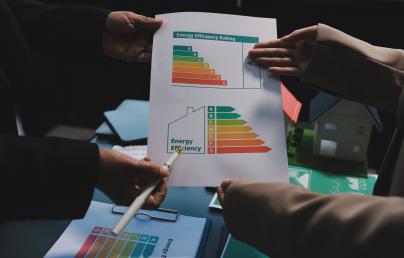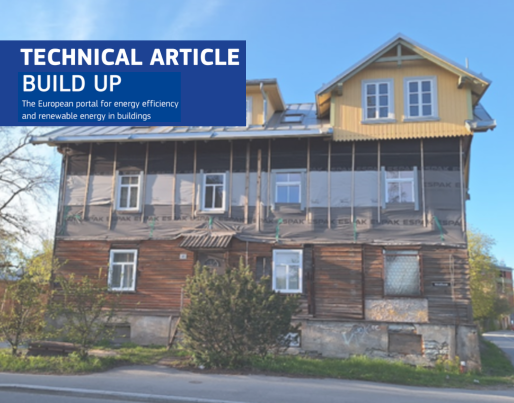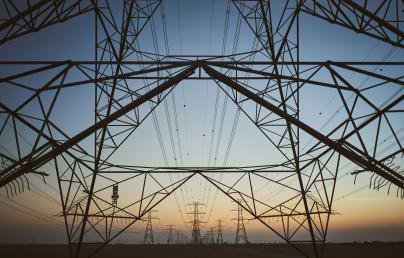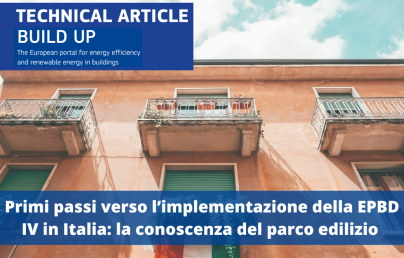
Energy renovations of historic homes: insights from the LIFE IP BuildEST Historic Building Renovation Living Lab

Energy renovations of historic homes: insights from the LIFE IP BuildEST Historic Building Renovation Living Lab
The article explores the strategies in renovating historic homes while improving their energy performance and indoor climate along with preserving heritage values. It highlights renovation challenges and financing complexities.
Authors
Murel Truu, Tallinn University of Technology | LinkedIn & personal profile
Anni Martin, Estonian Ministry of Climate | LinkedIn & personal profile
Targo Kalamees, Tallinn University of Technology | LinkedIn & personal profile
(Note: opinions in the articles are of the authors only and do not necessarily reflect the opinion of the EU).
Introduction
Estonian historical buildings, particularly those of considerable heritage value, typically exhibit poor energy performance in their original state [1], [2]. When it comes to preserving and protecting these buildings, it's crucial to prioritise the heritage and ensure that any renovation considers these values. Thus, the EU Renovation Wave [3] and the Energy Performance of Buildings Directive (EPBD) [4] have granted exemptions to buildings that are officially recognised as part of a designated environment or due to their architectural or historical significance from complying with energy performance requirements. Although such exceptions are permitted, the directive still promotes energy renovations that can be carried out without compromising the building's character or appearance.
Historic and heritage buildings not only shape the identity and character of our city centres, but they are also home for many inhabitants. A significant share (~20%) from European homes encompasses some historic value (Figure 1). Including these buildings in the ‘renovation marathon’ is crucial to ensuring the vitality of inner cities and a good living environment. Sustainable heritage conservation requires empowering residents to maintain their homes and avoid energy poverty, thus ensuring the continuation of our shared European heritage.
Figure 1: Breakdown of residential building by construction year [5]
These reasons motivated the LIFE IP BUILDEST project to establish a neighbourhood-level renovation living lab in a small Estonian town, Võru, that focuses on finding solutions for the challenge.
Neighbourhood level renovation
The LIFE IP BUILDEST project (2021-2028) was launched to support the full implementation of long-term renovation strategy of Estonian buildings (LTRS). The project, which is funded under LIFE Integrated Projects, includes various workflows, among which the neighbourhood-level renovation of residential homes forms a core testbed for both technological advancements as well as policy work. Parallel workflows have been set up to develop and test models to accelerate private residential renovations on the neighbourhood level in different Estonian cities, among which Võru town has set its focus on historic buildings (Figure 2). LIFE HeritageHome (2023-2026), a complimentary project for BUILDEST, aims to develop and pilot integrated renovation services for heritage homes of Estonia that will support the whole customer journey for owners of heritage homes who seek to improve the energy efficiency of their properties.
Figure 2: A peripheric regional centre, Võru town in the South-Eastern part of Estonia, has a population of 12 000 people. The town centre is primarily composed of one or two-story wooden or brick houses dating from the mid-19th to early 20th centuries. The old town of Võru has been designated a national heritage site due to its historical and architectural value. (Photo Kadi Mõttus, The National Heritage Board).
Targeting the renovation challenge on the neighbourhood level and integrated renovation services make it possible to not only pursue the improvement of the energy performance of individual homes but also enhance the overall liveability in the community. The original hypothesis for setting the scene was, that collective encouragement would increase the regional capacity and local social capital in pursuing energy goals of residential retrofits, moreover, larger construction volumes and scale effect would allow to achieve a higher quality of work and reduce renovation costs [6]. To test this, in the BUILDEST project a group of experts from Tallinn University of Technology, Estonian Academy of Arts and Tartu Regional Energy Agency supported local town government in developing the renovation concepts for the buildings in the targeted neighbourhood who were interested in the renovation.
Võru living lab aims to facilitate neighbourhood-level energy-efficient renovation of historic buildings to achieve > 60% reduction in heating energy consumption and achieve an energy performance certificate (EPC) class ‘C’ for eight buildings. Additionally, the lab aims to provide renovation advice to owners of 25 buildings with similar perspectives. Functioning as a knowledge transfer and consultancy service, the project empowered homeowners rather than directly financing renovations. The practical renovations would rely largely on complementary funding (national renovation grants [7], [8] and private investments.
During the initial phase (2022-2023), the living lab fostered community engagement through eight public seminars and workshops for homeowners and residents. These events addressed historic building renovation needs, possibilities, and participation criteria. Additionally, on-site consultations were conducted for 18 buildings, and five open calls for project participation were issued.
Renovation concepts for the buildings
The consultation process resulted in renovation concepts developed for all the buildings interested in energy retrofits in the living lab. The concepts served as analogue renovation passports, as included descriptions of heritage sensitive renovation measures as well as the corresponding energy calculations and preliminary financial planning of the planned renovation works. Additionally, the financial savings achieved through the reconstruction solutions were calculated based on current energy costs.
The technical condition and indoor climate of the heritage homes are generally poor [9], [10], mainly due to a combination of long-term deferred maintenance, improper maintenance and the resulting water and moisture damage. Other issues included foundation subsidence and soil water seeping into the basement, as well as two buildings experiencing significant damage from being unoccupied. The severe reality of the living conditions in these buildings came as a surprise to many experts. While the original hypothesis was that co-created renovation concepts should prioritise untangling the heritage constraints, the actual focus shifted towards the necessary work to preserve the buildings and ensure basic living conditions with the limited available budgets owners had available.
Therefore, the renovation concepts included different works that secure the structures and establish adequate living conditions (modernisation of electricity system, connecting with public sewage network, planning bathrooms and toilets into the apartments). While such works do not contribute to the energy performance and heritage value, then these are very important motivations for the owners to initiate the property retrofit. In addition to the indispensable works, the renovation concept included many reconstruction packages for the selected buildings, encompassing various construction and service system solutions designed to balance energy performance with heritage protection.
One renovation package focused on improving energy performance within these constraints, while another package incorporated onsite renewable energy solutions. The most suitable renewable energy solution in heritage settings - the solar panels, was found to be highly efficient. The results showed that, on average, heat loss was reduced by 60%, primary energy use was reduced by 58% with renewable energy solutions, and by 49% without renewable energy solutions. In five buildings, it was possible to achieve an energy performance certificate (EPC) class ‘C’, in one building class ‘D’ and the remaining five achieving class ‘C’ together with onsite renewable energy generation solutions (Figure 3) [11].
Figure 3: Original state and renovation packages of six selected heritage buildings identified in the first round of Võru living lab. Red dot – strict regime, yellow dot – moderately strict regime, green dot – building located in heritage zone; however no significant constraints are applied to its renovation.
The heritage constraints for the six example buildings differed due to the varying character and uniqueness of the buildings. While obviously the biggest energy saving potential was designed for the least strictly protected building and the smallest gain could be achieved for the most strictly protected structures then in reality the energy saving potential is not fully correlated to the heritage regime strictness but rather to the building character.
Kreutzwaldi 2 case study: how to achieve net-zero without significant loss to heritage values
In addition, we showed that it is possible to go beyond standard renovation concepts and actually design an ambitious renovation solution that allowed to reach the status of nearly zero-energy building (nZEB) and resulted in the designed EPC ‘A’ without losing building heritage values (Figure 4). Kreutzwaldi 2 building was selected as a pilot for a complementary RESTO project [12], which conceptualised and analysed the impacts of different renovation strategies.
Figure 4: Building at Kreutzwaldi 2, Võru, before renovation (left) and after possible designed renovation (right, by Tõra, K and Kangro K., 2023).
These scenarios included different levels of ambition for the energy renovations (EPC classes C to A), along with these the current national practice of heritage restoration (business as usual) was analysed. For all these strategies a life-cycle assessment (LCA) was carried out [13]. While the preservation of historic buildings is undeniably important for conserving the embodied energy stored in these structures, it is equally crucial to recognise that current practices that only allow for modest improvements in energy performance are not the most effective in reducing use-stage emissions. In fact, these practices can be detrimental to the environment due to the increased production and use of materials, which ultimately outweigh the benefits of minimal insulation in terms of energy savings (as illustrated in Figure 5).
Figure 5: The influence of carbon footprint on different energy performance. The same material combinations were used - based on the final design project. Differences between efficient district heating system (EffDH) and ground source heat pumps (GSHP) were analysed [13].
The renovation concepts and concrete designs of heritage buildings in Võru living lab depicted above demonstrate that even in buildings protected as part of heritage, it is possible to attain substantial energy savings and an enhanced EPC class. The pilot revealed that the selected technical system solutions, such as renewable energy alternatives, can offer substantial energy efficiency improvements and elevate the energy class of all buildings by at least one level.
The condition of the building's exterior facade and roofing of historic homes is in general in such a state that it needs to be replaced both to protect the underlying structures and to improve the exterior of the building. This is a typical situation when the service life of the unmaintained wooden boarding is more than 40 – 50 years. Therefore, a comprehensive complete renovation has to be done anyway to extend the service life of the building. If additional insulation is needed anyway, it is reasonable to choose the thickness of the insulation in such a way that heat loss can be minimised.
A significant learning point is that changes in the business-as-usual practices of renovating heritage buildings need a comprehensive co-creation process and detail solutions already in the early stages of design approval to guarantee appreciation of heritage details, proportions and materials. In case of our case building (Kreutzwaldi 2) the values could be preserved by insulating walls and roof together and moving windows outward. This allowed to keep the façade’s historic profile, Figure 6.
Figure 6: Deep energy renovation to nZEB level preserves historical building’s ( Kreutzwaldi 2, Võru) original façade profile because both, roof and external wall need to be insulated [14].
If energy renovation grants or subsidies are available, it is feasible to achieve EPC class A, B, or C within reasonable parameters. This necessitates insulating the external walls, floor and roof, as well as installing a mechanical ventilation system with heat recovery and efficient heat source. With a 50% grant and the implementation of PV panels, cost optimality is advantageous with both the efficient district heating and ground source heat pump systems [13]. Currently supported solutions by the National Heritage Board are not cost-effective because they involve adding new materials (such as paint and/or wooden cladding) without visible energy savings.
Harsh reality
Despite attracting 20 applications through open calls, only one building has proceeded to actual design stage. In case of the Kreutzwaldi 2 building, for which the design for A class renovation was completed with Renovation Strategy Tool (RESTO) funds (see above, Figure 4), the bank rejected the mortgage offer and was not willing to issue the loan for implementing the designed renovation. The harsh reality is that owners of heritage buildings lack the resources to carry out neither the energy renovations nor the indispensable renovations securing the structures and establishing the liveability we expect to consider normal in the 21st century.
The core problem, as identified through owner surveys, on-site visits, and consultations, is surprisingly not overly restrictive heritage regulations. The Võru living lab experience demonstrates heritage authorities' willingness to explore compromise solutions in historic building renovations as well as provide financial assistance for indispensable renovation works. The living lab has unveiled several problematic situations in which heritage conservation and renovation objectives are clearly overshadowed by social concerns. Despite this, even the average households in the historic town centre do not have adequate incomes or the ability to secure loans using their real estate to finance the necessary energy renovations.
Võru's historic buildings face a significant renovation backlog, with many lacking essential 21st-century amenities like hot and cold running water, private bathrooms, and toilets inside apartments. Creating these basic conditions alone can cost up to €500/m², posing a substantial financial barrier before even considering energy-saving measures. This dire state of disrepair and the high cost of comprehensive renovation render the current project's ambitions unrealistic for many buildings. Initial estimates indicate a total project cost of >€40,000 per building and construction costs of €1500/m².
Figure 7: One of the oldest buildings in Võru heritage site includes high heritage value but extremely inadequate sanitary conditions for the few remaining inhabitants. According to the renovation concept approved by heritage authorities, this building could reach energy class C with cutting 57.4% from the current energy use. (Photo: Maris Mändel).
The Võru living lab experience highlights a critical lesson: comprehensive renovation of historic buildings is unlikely to succeed solely through individual owner contributions, limited savings, and constrained borrowing capacity. Even with additional funding from the Heritage Board and project-supported historical research and administrative support, many historic small apartment buildings and individual houses in city centres require investments far exceeding owners' means. Furthermore, the burden of preserving a shared societal good – cultural heritage – disproportionately falls on individual property owners, with limited state support for preservation and modernization efforts. Grants for heritage preservation and modernisation remain marginal.
Staged renovation as a feasible alternative?
A separate study carried out by BUILDEST to assess the cultural and environmental value of historic sites [15] showed that a culture of step-by-step (staged) renovation emerges, contributing to an eclectic appearance of the historically valuable area and promoting the use of inappropriate materials.
The renovation of a historic building is a complex undertaking that involves numerous construction challenges, as well as interdependent regulatory, social, technological, and financial considerations (Figure 8). As a result, the feasibility of a renovation plan is heavily reliant on these factors. Altering the plan to address the needs of one factor may not align with the others.
Figure 8: Feasibility of heritage renovation poses challenges in different categories.
Concentrating only on the financial viability of renovations may involve making sacrifices in terms of retaining historical features and reducing energy expenses for homeowners. Staged renovations which seem as first option to cut costs, can result in tainted milieu in the heritage site as well as recurring costs, as works already done need to be adjusted in following stages (Figure 9).
Figure 9: Would staged renovation fit in heritage sites? (Photo: Murel Truu)
The Võru living lab experience underscores the difficulties of achieving comprehensive historic building renovation in a single phase without external funding. This necessitates the development of practical strategies for staged renovation approaches. To ensure the success of a staged renovation, it is essential to prioritise and sequence work. This approach ensures a logical progression that avoids undoing previous efforts in subsequent stages. Piecemeal upgrades can lead to suboptimal outcomes, such as inadequate heating efficiency or solutions with shorter lifespans. In addition, such an approach may require costly rework in later phases. Once time and resources have been expended on an inefficient approach, addressing these issues in the near future becomes improbable, leading to a ‘renovation deadlock.’
Conclusions
Key Findings:
Heritage homes face a significant ‘renovation debt’, compounded by limited homeowner knowledge, capacity and a vulnerable resident/owner's population. Solely relying on private resources for renovation proves insufficient. Support measures require more targeted allocation and adaptation to the specific needs of historical and small residential buildings to enhance their feasibility.
For a long period, the business-as-usual practice for heritage buildings comprehensive renovations does not include energy performance works, the precautionary standard practice can be an obstacle to the energy-efficient renovation of historic homes. Heritage authorities in LIFE IP BUILDEST and heritageHOME have been progressive in cocreating novel solutions and are willing to improve the standard practices in Estonia.
We showed that deep renovation of the entire building, considering all the different building envelope parts and solving the joints of the facade elements, as a result of which the energy performance and indoor climate of the historic building can be significantly improved without deteriorating the architectural appearance of the building.
Staged renovation needs to be avoided or if needed well planned to avoid ‘renovation deadlocks’.
References
[1] E. Arumägi and T. Kalamees, “Analysis of energy economic renovation for historic wooden apartment buildings in cold climates,” Applied Energy, vol. 115, pp. 540–548, Feb. 2014, doi: 10.1016/j.apenergy.2013.10.041.
[2] Ü. Alev et al., “Renovation alternatives to improve energy performance of historic rural houses in the Baltic Sea region,” Energy and Buildings, vol. 77, pp. 58–66, Jul. 2014, doi: 10.1016/j.enbuild.2014.03.049.
[3] “COMMUNICATION FROM THE COMMISSION TO THE EUROPEAN PARLIAMENT, THE COUNCIL, THE EUROPEAN ECONOMIC AND SOCIAL COMMITTEE AND THE COMMITTEE OF THE REGIONS A Renovation Wave for Europe - greening our buildings, creating jobs, improving lives.” Accessed: Nov. 06, 2021. [Online]. Available: https://eur-lex.europa.eu/legal-content/EN/TXT/?uri=CELEX%3A52020DC0662
[4] “Directive - EU - 2024/1275 - EN - EUR-Lex.” Accessed: May 11, 2024. [Online]. Available: https://eur-lex.europa.eu/eli/dir/2024/1275/oj
[5] “EU Building Stock Observatory - Factsheets.” Accessed: May 11, 2024. [Online]. Available: https://building-stock-observatory.energy.ec.europa.eu/factsheets/
[6] M. Truu, L. Lihtmaa, and M. Niinemägi, “Revitalizing Modernist Districts: Neighbourhood Level Mass-Renovation with SOFTacademy Project,” Journal of Sustainable Architecture and Civil Engineering, vol. 34, no. 1, Art. no. 1, Feb. 2024, doi: 10.5755/j01.sace.34.1.35646.
[7] K. Kuusk and T. Kalamees, “Estonian Grant Scheme for Renovating Apartment Buildings,” Energy Procedia, vol. 96, pp. 628–637, 2016, doi: 10.1016/j.egypro.2016.09.113.
[8] A. Mikola, A. Hamburg, K. Kuusk, T. Kalamees, H. Voll, and J. Kurnitski, “The impact of the technical requirements of the renovation grant on the ventilation and indoor air quality in apartment buildings,” Building and Environment, vol. 210, p. 108698, Feb. 2022, doi: 10.1016/J.BUILDENV.2021.108698.
[9] E. Arumägi, T. Kalamees, and U. Kallavus, “Indoor climate conditions and hygrothermal loads in historic wooden apartment buildings in cold climates,” Proceedings of the Estonian Academy of Sciences, vol. 64, no. 2, pp. 146–156, 2015, doi: 10.3176/proc.2015.2.03.
[10] P. Klõšeiko, T. Agasild, and T. Kalamees, “Deterioration of building envelope of wooden apartment buildings built before 1940 based on external survey,” in Nordic Symposium of Building Physics, Tampere, Finland 29 May – 2 June, 2011, pp. 917–924.
[11] A. Palanen and L. Pedassaar, “Energiatõhususe parandamise võimalused Võru linna miljööväärtuslike hoonete näitel,” May 2023, Accessed: May 11, 2024. [Online]. Available: https://dspace.tktk.ee/handle/20.500.12863/4850
[12] “Renovation Strategy Tool,” FinEst Centre. Accessed: May 11, 2024. [Online]. Available: https://finestcentre.eu/project-pilot/renovation-strategy-tool/
[13] K.-A. Kertsmik, E. Arumägi, J. Hallik, and T. Kalamees, “Low carbon emission renovation of historical residential buildings,” Energy Reports, vol. 11, pp. 3836–3847, Jun. 2024, doi: 10.1016/j.egyr.2024.03.030.
[14] A. Evard, E. Arumägi, S. Lomp, and T. Kalamees, “Energy and hygrothermal performance challenges in the renovation of a over 100-year-old wooden apartment building into a nearly zero-energy building,” presented at the 2nd International Conference on Moisture in Buildings 2023, ScienceOpen, Jun. 2023. doi: 10.14293/ICMB230053.
[15] E. Liiva, H. Rummo, K. Ambrozevits, A. Ojari, A. Lomp, and T. Kalamees, “Assessment of the Renovation Need, Material Authenticity, and the Cultural and Environmental Value of Historic Apartment Building Neighbourhoods,” Journal of Sustainable Architecture and Civil Engineering, vol. 34, no. 2, 2024.

